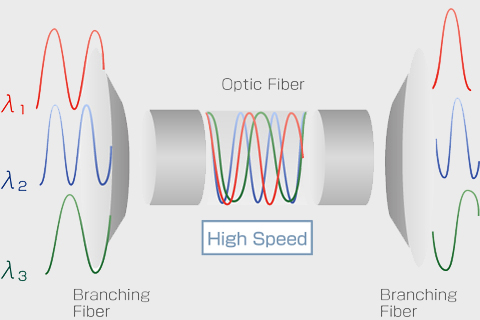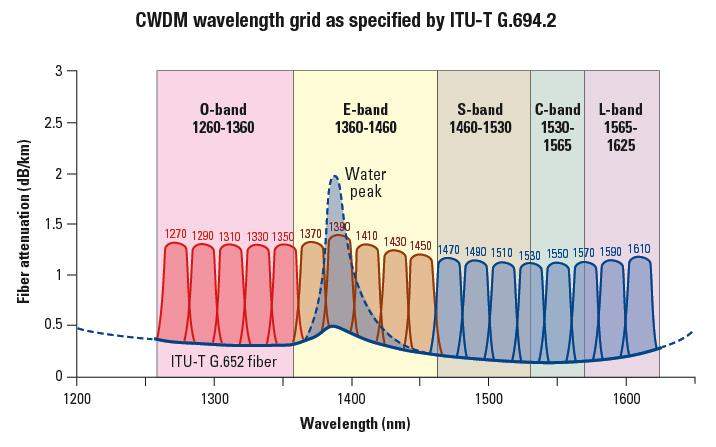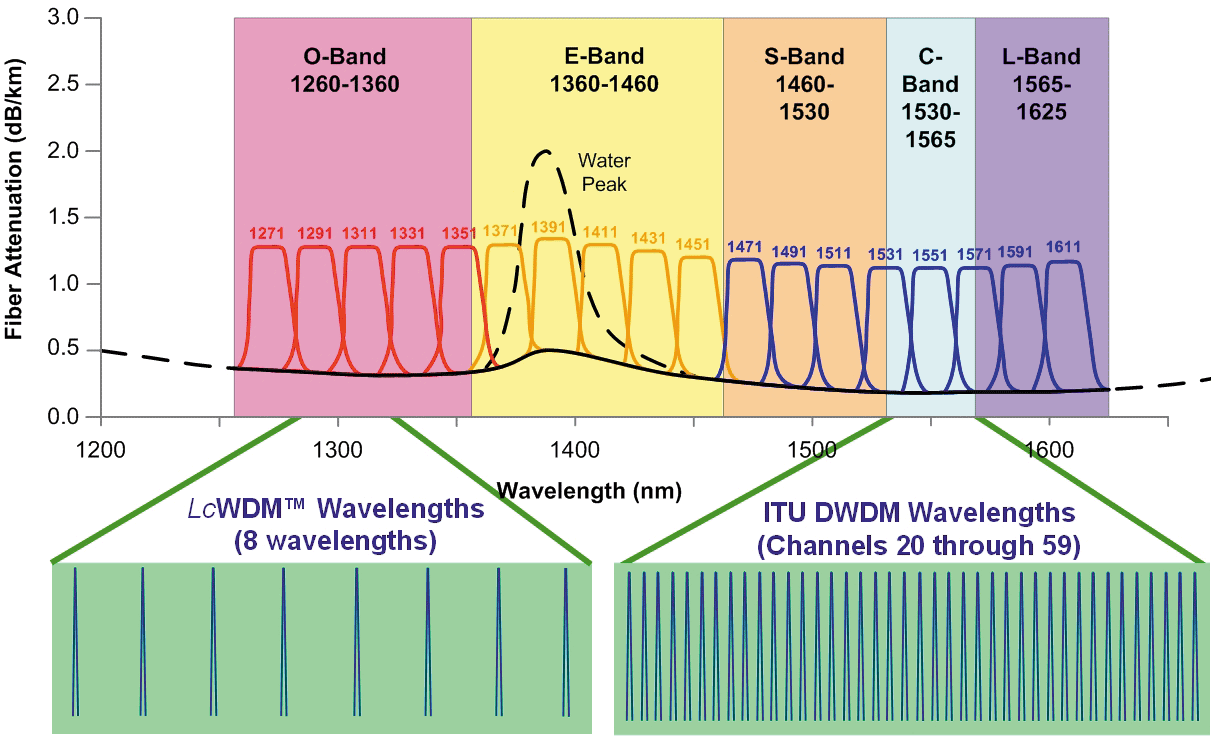Great Savings in Network Equipment & Spares
Fiber optics
From the PoP to the customer: layer 3, layer 2 and layer 1 equipment
A common question is, how long can I reach from my layer 3/2 equipment, with pluggable optics and/or passive optical transport? The following table gives an answer.
(*) Maximum reach is obtained with highest power budget transceivers. In addition to fiber attenuation, It needs to be accounted the looses produced by optical multiplexors, patchcords and pannels, fusion splices, etc.
When you need to reach a larger distance, then you have to amplify the optical signal, or repeat in a middle point, between both ends.
Background on fiber optics
Wavelength-division multiplexing (WDM) is the practice of multiplying the available capacity of optical fibers through use of parallel channels, each channel on a dedicated wavelength of light. This requires a wavelength division multiplexer in the transmitting equipment and a demultiplexer (essentially a spectrometer) in the receiving equipment. Using WDM technology now commercially available, the bandwidth of a fiber can be divided into as many as 160 channels to support a combined bit rate in the range of 1.6 Tbit/s.

WDM systems are divided into different wavelength patterns, conventional/coarse (CWDM) and dense (DWDM). Conventional WDM systems provide up to 8 channels in the 3rd transmission window (C-Band) of silica fibers around 1,550 nm. Dense wavelength division multiplexing (DWDM) uses the same transmission window but with denser channel spacing. Channel plans vary, but a typical system would use 40 channels at 100 GHz spacing or 80 channels with 50 GHz spacing. Wavelength Division Multiplexing (WDM) enables carriers to deliver more services over their existing optical fiber infrastructure by combining multiple wavelengths on a single fiber. Each service is carried over a separate wavelength, thus increasing the capacity of the fiber by the number of wavelengths transmitted. Coarse Wavelength Division Multiplexing (CWDM) and Dense Wavelength Division Multiplexing (DWDM) are both mature WDM technologies, using standardized ITU-T wavelengths.
CWDM and DWDM differ in complexity, offered capacity, cost and the markets they address. Due to its low cost and simple deployment, CWDM is a good fit for access networks and many metro/regional networks.
CWDM
CWDM is a form of multiplexing that has wider spacings between the wavelengths used than dense WDM (DWDM). Also, unlike DWDM, it uses a far broader photonic band spectrum. Up to 18 wavelengths can be transported on a single fiber using CWDM. The costs of deploying CWDM are significantly lower than DWDM.
The main characteristic of the ITU CWDM standard is that the signals are not spaced appropriately for amplification by EDFAs. This therefore limits the total CWDM optical span to somewhere near 80 km for a 2.5 Gbit/s signal, which is suitable for use in metropolitan applications.
As defined by the International Telecommunications Union (ITU-T, G.694.2), CWDM wavelengths cover the 1270- to 1610-nm range in 20-nm increments (see fig). The most commonly used groups are:
- from 1510 to 1570 nm for 4 wavelengths,
- from 1470 to 1610 nm for 8 wavelengths,
- from 1270 to 1610 nm for 16 wavelengths (without 1450 nm and optionally 1390 or 1430 nm)

Green Technology
Passive CWDM is an implementation of CWDM that uses no electrical power. It separates the wavelengths using passive optical components such as bandpass filters and prisms.
- no power consumption
- no air-conditioning needed
- Zero latency!
- Outside Plant Enabled (street cabinets, splice enclosures, ...)

DWDM
Dense wavelength division multiplexing (DWDM) refers originally to optical signals multiplexed within the 1550 nm band so as to leverage the capabilities (and cost) of erbium doped fiber amplifiers (EDFAs), which are effective for wavelengths between approximately 1525 to 1565 nm (C band), or 1570 to 1610 nm (L band).

EDFA Amplifiers
EDFAs can amplify any optical signal in their operating range, regardless of the modulated bit rate. In terms of multi-wavelength signals, so long as the EDFA has enough pump energy available to it, it can amplify as many optical signals as can be multiplexed into its amplification band (though signal densities are limited by choice of modulation format).
EDFAs therefore allow a single-channel optical link to be upgraded in bit rate by replacing only equipment at the ends of the link, while retaining the existing EDFA or series of EDFAs through a long haul route.

Furthermore, single-wavelength links using EDFAs can similarly be upgraded to WDM links at reasonable cost. The EDFA's cost is thus leveraged across as many channels as can be multiplexed into the 1550 nm band.

